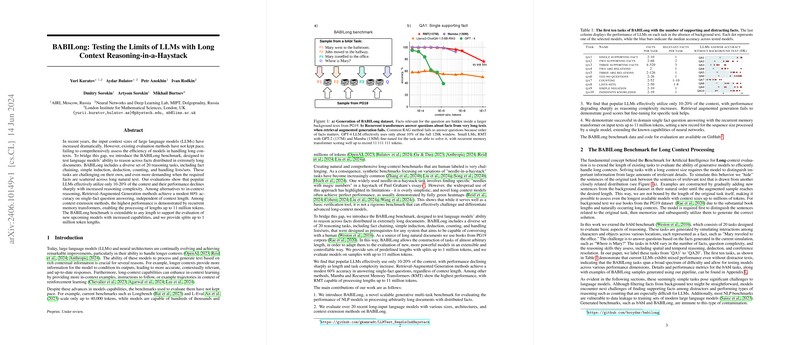BABILong: Evaluating Long Context Reasoning in LLMs
The paper introduces the BABILong benchmark, advancing current methodologies by testing LLMs on their ability to perform reasoning tasks across very lengthy contexts. As LLMs continue to grow, with input context sizes extending up to hundreds of thousands or even millions of tokens, traditional evaluation benchmarks are proving inadequate. This research outlines a novel approach to overcome these limitations, crucially addressing the need for scalable, comprehensive evaluation methods in the field of NLP.
Benchmark Overview
BABILong is structured to evaluate LLMs through a series of 20 diverse reasoning tasks. These tasks require models to perform operations such as fact chaining, deduction, and induction across scattered facts within lengthy documents. Each task requires the model to identify the relevant context or "needles" within a "haystack" of text, deriving conclusions from multiple interrelated facts. The benchmark uniquely challenges LLMs by blending the tasks within natural, extensive text derived from the PG19 corpus, a significant collection of pre-1919 books. Synthesized distractor content drawn from similar distribution enriches the test conditions, thus heightening complexity and closer approximating real-world reasoning challenges encountered in extensive documents.
Principal Findings
The research establishes that contemporary LLMs struggle to capitalize efficiently on their full input capability, often leveraging only a fraction of available context. Evaluation results reveal that leading LLMs effectively harness roughly 10-20% of their full context window, with performance degrading as complexity and length increase. For instance, stimulus tests show that models’ competency diminishes considerably with rising complexity in multiple fact situations, underscoring a critical need for enhanced context utilization strategies.
Despite technological advancements like Retrieval-Augmented Generation (RAG), which anticipates improvement in model accuracy by reducing context size through pertinent fact retrieval, performance largely remains limited. RAG achieves a modest accuracy increment, emphasizing the need for models to transcend current strategies for high-fidelity context assimilation. Conversely, recurrent memory transformers demonstrate promising capabilities, enabling context processing up to lengths of 11 million tokens, a haLLMark finding that suggests potential pathways for LLM architecture development.
Implications and Future Directions
BABILong provides substantial insights into the operational limitations and potential of LLMs, catalyzing future research across several fronts. For research and industry, the implications are twofold:
- Model Improvement: There is scope for significant enhancement in LLM architecture design, particularly those incorporating memory mechanisms for efficient context scaling. Exploration of hybrid models that blend retrieval, recurrence, and attention strategies may yield substantial gains.
- Benchmark Development: Future work could consider incorporating diverse linguistic corpora and expand the reasoning task spectrum to include multidimensional challenges, effectively pushing model evaluation towards more intuitive real-world applications.
BABILong is extensible and adaptable, offering a scalable framework aligned with emerging LLM capabilities. It propels future AI research towards more accurate and nuanced understanding and manipulation of large-scale text contexts, an imperative for the evolution of AI systems capable of real-world problem-solving. By refining both benchmarks and models, continued advancement becomes possible, thereby enhancing the applicability and sophistication of AI reasoning systems.
